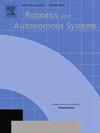具有质量中心偏移补偿功能的单点悬挂式机械手的差分运动学原理
IF 4.3
2区 计算机科学
Q1 AUTOMATION & CONTROL SYSTEMS
引用次数: 0
摘要
单缆悬挂式机械手适用于无人驾驶飞行器(UAV)的空中作业任务和深井搜救等特殊场合。然而,由于底座缺乏完整约束,机械手在运动过程中会因质量中心偏移而产生末端位置误差。本文首先建立了重心偏移模型,并在此基础上改进了雅各布矩阵,实现了单缆悬挂机械手的微分运动学求解。此外,通过在雅各布矩阵中引入 CoM 移位的约束条件,可以实现末端和质心运动的同步规划。这可以有效避免机械手在悬挂点存在弹性或不稳定的情况下发生摆动。模拟和原型实验都有效地验证了所提方法的有效性。利用本文的方法,Z 轴和 X 轴的平均轨迹误差可分别从 27.0 ± 2.6 mm 减小到 5.6 ± 3.4 mm 和 43.0 ± 64.2 mm 减小到 3.3 ± 4.8 mm。本文章由计算机程序翻译,如有差异,请以英文原文为准。
Differential kinematics of a single-point-suspended manipulator with center-of-mass shift compensation
The single cable-suspended manipulator is suitable for special occasions such as aerial operation tasks of unmanned aerial vehicles (UAVs) and deep-well search and rescue. However, due to the lack of complete constraints at the base, the manipulator will have errors in end position due to the center-of-mass offset during the motion. In this paper, the model of CoM shifting is established, and the Jacobian matrix is improved based on this model, to realize the differential kinematics solution for the single cable-suspended manipulator. In addition, by introducing the constraint of CoM shift in the Jacobian matrix, it makes it possible to synchronize the planning of the motion of the end and the center of mass. This can effectively avoid the wobbling of the manipulator in the presence of elasticity or instability at the suspension point. Both simulation and prototype experiments effectively verify the effectiveness of the proposed method. Using the method of this paper, the average error of the trajectories in the z-axis and x-axis can be reduced from 27.0 ± 2.6 mm to 5.6 ± 3.4 mm, and 43.0 ± 64.2 mm to 3.3 ± 4.8 mm, respectively.
求助全文
通过发布文献求助,成功后即可免费获取论文全文。
去求助
来源期刊

Robotics and Autonomous Systems
工程技术-机器人学
CiteScore
9.00
自引率
7.00%
发文量
164
审稿时长
4.5 months
期刊介绍:
Robotics and Autonomous Systems will carry articles describing fundamental developments in the field of robotics, with special emphasis on autonomous systems. An important goal of this journal is to extend the state of the art in both symbolic and sensory based robot control and learning in the context of autonomous systems.
Robotics and Autonomous Systems will carry articles on the theoretical, computational and experimental aspects of autonomous systems, or modules of such systems.
 求助内容:
求助内容: 应助结果提醒方式:
应助结果提醒方式:


